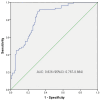Perinatal factors for antepartum hemorrhage in women with placenta accreta spectrum
- PMID: 40636918
- PMCID: PMC12238052
- DOI: 10.3389/fsurg.2025.1588498
Perinatal factors for antepartum hemorrhage in women with placenta accreta spectrum
Abstract
Introduction: Placenta accreta spectrum with antepartum hemorrhage is closely related to maternal and fetal morbidity and mortality. It is of utmost importance to predict the possibility of antepartum hemorrhage using perinatal factors before delivery in women with placenta accreta spectrum. The aim of this study is to identify the risk factors for antepartum hemorrhage in women with placenta accreta spectrum.
Methods: This retrospective cohort study evaluated pregnant women with placenta accreta spectrum. Multivariate logistic regression was used to identify the independent variables associated with antepartum hemorrhage and a nomogram was developed to predict the possibility of antepartum hemorrhage. An Excel form computer interface was constructed to use the prediction model.
Results: This retrospective cohort study included 188 participants (74 with antepartum hemorrhage). According to multivariate logistic regression analysis, blood type O [odds ratio (OR) 2.277, confidence interval (CI) 1.220-4.250], history of miscarriage (2.178, 95% CI 1.114-4.261), and parity (1.701, 1.037-2.790) were independent risk factors for antepartum hemorrhage in women with placenta accreta spectrum.
Discussion: This results revealed that women with placenta accreta spectrum with blood type O, history of miscarriage, and multiparity may have a significant risk of experiencing antepartum hemorrhage.
Keywords: antepartum hemorrhage; nomogram; placenta accreta spectrum; placenta previa; risk factor.
© 2025 Hu, Ye, Zhou, Guo and Fan.
Conflict of interest statement
The authors declare that the research was conducted in the absence of any commercial or financial relationships that could be construed as a potential conflict of interest.
Figures




Similar articles
-
Prenatal ultrasound diagnosis and outcome of placenta previa accreta after cesarean delivery: a systematic review and meta-analysis.Am J Obstet Gynecol. 2017 Jul;217(1):27-36. doi: 10.1016/j.ajog.2017.02.050. Epub 2017 Mar 6. Am J Obstet Gynecol. 2017. PMID: 28268196
-
Pathologically diagnosed placenta accreta spectrum without placenta previa: a systematic review and meta-analysis.Am J Obstet Gynecol MFM. 2023 Aug;5(8):101027. doi: 10.1016/j.ajogmf.2023.101027. Epub 2023 May 19. Am J Obstet Gynecol MFM. 2023. PMID: 37211089
-
Risk factors, prenatal diagnosis, and outcome of posterior placenta accreta spectrum disorders in patients with placenta previa or low-lying placenta: A multicenter study.Acta Obstet Gynecol Scand. 2025 Jul;104(7):1328-1338. doi: 10.1111/aogs.15132. Epub 2025 May 19. Acta Obstet Gynecol Scand. 2025. PMID: 40387324 Free PMC article.
-
Development and validation of a model to preoperatively predict the risk of placenta accreta spectrum in women with placenta previa.Adv Clin Exp Med. 2025 Jul;34(7):1145-1153. doi: 10.17219/acem/191828. Adv Clin Exp Med. 2025. PMID: 39675014
-
Delivery outcomes in the subsequent pregnancy following the conservative management of placenta accreta spectrum disorder: a systematic review and meta-analysis.Am J Obstet Gynecol. 2024 May;230(5):485-492.e7. doi: 10.1016/j.ajog.2023.10.047. Epub 2023 Nov 2. Am J Obstet Gynecol. 2024. PMID: 37918506
References
-
- Jauniaux E, Hussein AM, Thabet MM, Elbarmelgy RM, Elbarmelgy RA, Jurkovic D. The role of transvaginal ultrasound in the third-trimester evaluation of patients at high risk of placenta accreta spectrum at birth. Am J Obstet Gynecol. (2023) 229:445.e1–445.e11. 10.1016/j.ajog.2023.05.004 - DOI - PubMed
LinkOut - more resources
Full Text Sources

